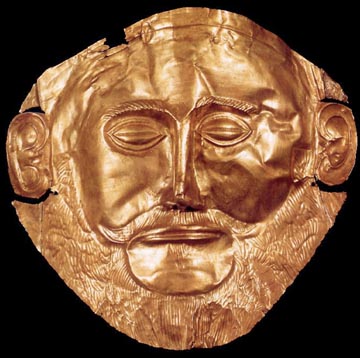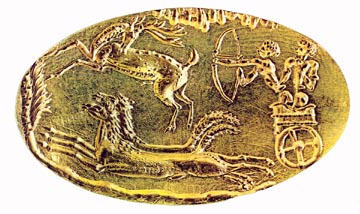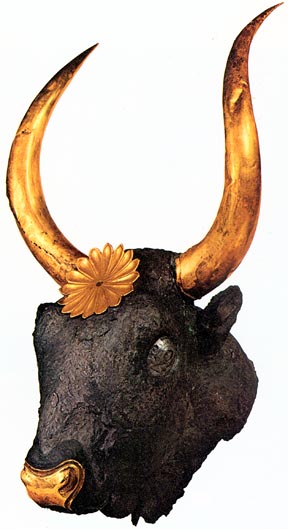His object there was to discover the graves of Agamemnon and his
contemporaries which, following Pausanias, he believed to be located within the Cyclopean walls. He had already in 1874 cut 34 trial pits inside the citadel and within a hundred yards of the Lion Gate had found, besides remains of walls and small painted clay figurines of women and cows, an unsculptured slab which he took for a gravestone. He therefore concentrated on the area and within a few months uncovered the now famous Grave Circle, a double ring of vertical stone slabs about four feet high, enclosing an area about 87 feet in diameter.
Originally the space between the uprights had been covered over by horizontal
slabs jointed to them, so as to form what seemed - until the full height was
uncovered - a stone bench. Schliemann at first identified this area as the
agora, the place of assembly where, in Homer's epic, the elders gathered
for debate seated "upon smoothed stones." On the east side the circle was
founded upon the out-cropping limestone of the hillside, but most of the space
enclosed had been built up to a horizontal level with earth and stones supported on the west side by a big curving terrace wall.
Approximately at this level he found a number of undoubted grave stones with relief carvings of a kind still unusual except at Mycenae. In most cases the upper part of the rectangle is filled with linked spirals, while the lower halves contain rather crude pictorial scenes of warriors driving in chariots or in combat with wild beasts (for example). The stones were the markers for "Shaft Graves" (schachtgräber - a better translation might have been pit graves) which had been cut in the soft rock many feet below, doubtless at a time when the natural slope of the hill was still exposed. Schliemann excavated five of these graves, and a sixth was found and cleared shortly afterwards by Panagiotis Stamatakis, who represented the Greek authorities during the excavations.
The contents of these graves were so startlingly rich that no one could quarrel with their description as "royal," and it is not surprising that Schliemann believed he had discovered exactly what he sought.
The grave pits, which varied in size from about 10 feet by 12 to 15 by 21, and
in depth from about 3 feet to 15, were lined for part of their depth with stone
walling which had originally supported a covering of stone slabs resting on
wooden beams. The dead, 19 individuals in all, including three women and two
infants, were laid on a floor of pebbles, often in a contracted rather than
extended posture.
Over the faces of some of the men were masks of gold foil. The women had golden frontlets or diadems, and numerous discs of thin gold with relief patterns of spirals, rosettes, butterflies, or cuttle fish, seem to have adorned the robes they wore. The infants were wrapped in gold foil.
Besides personal ornaments - including bracelets, large pins with crystal knobs, signet rings of gold there was a profusion of other objects laid with the bodies: vases of pottery and of faience; large bowls and jugs of bronze; several sophisticated vases of alabaster; cups and stemmed goblets of gold and silver, some plain, some with relief ornament (see the contents of Graves 1–VI. One gold goblet had figures of doves perched on the handles, which for Schliemann at once recalled Homer's description of a golden cup or bowl which the aged hero Nestor had with him at Troy.
Warfare was clearly a prime interest of the people buried in Grave Circle A. Beside the men lay a wealth of bronze weapons spearheads, swords, and daggers. The best of the swords had hilts plated with gold, and pommels of ivory or crystal. Subsequent cleaning showed that some dagger blades had exquisite pictorial scenes of animals and hunting inlaid with considerable skill in gold and silver and niello.
For the most part the style of the Shaft Graves finds were totally new to archaeology.

Mask from shaft grave V at Mycenae
LH I
Gold
Height 101/2 inches
(National Archaeological Museum, Athens)
The unique and famous gold masks from Grave Circle A at Mycenae are probably the most well-known gold objects from this civilization. The best
preserved and most individualistic of the group found by Schliemann was for a time mistakenly considered the mask of Agamemnon. It is a good
example of the goldwork found in royal Mycenaean graves. It probably belonged to a ruler and was almost certainly a death mask. Despite stylizations
such as the scroll-shaped ears, its more distinctive features - the thin lips and curved mustache - are clearly those of a particular person.

Daggers from shaft graves IV and V at Mycenae
LH II
Bronze, with gold, silver, and niello inlay
Lengths from 6 to 9 inches
(National Archaeological Museum, Athens)
The scene on one of the dagger blades shows male hunters carrying large shields, semi-cylindrical or figure-of-eight shaped. The scene on another dagger, with leopards and wild fowl among papyrus beds, has an Egyptian flavour


Signet ring from shaft grave IV at Mycenae
LH I
Gold
Diameter 11/5 inches
(National Archaeological Museum, Athens)
A scene of two male figures, one with a bow and arrow, riding in a chariot pulled by two horses hunting a stag.

Rhyton in the form of a bull's head from shaft grave IV at Mycenae
LH I
Silver with gilt horns and trimmings in gold
(National Archaeological Museum, Athens)
A silver rhyton in the form of a bull's head, with horns of gold and a gold rosette on the forehead possibly imported from Minoan Crete (see an example of a Minoan bull's head rhyton)

 SPRING 2016
SPRING 2016  SCHEDULE
SCHEDULE  REQUIREMENTS
REQUIREMENTS

 SPRING 2016
SPRING 2016  SCHEDULE
SCHEDULE  REQUIREMENTS
REQUIREMENTS